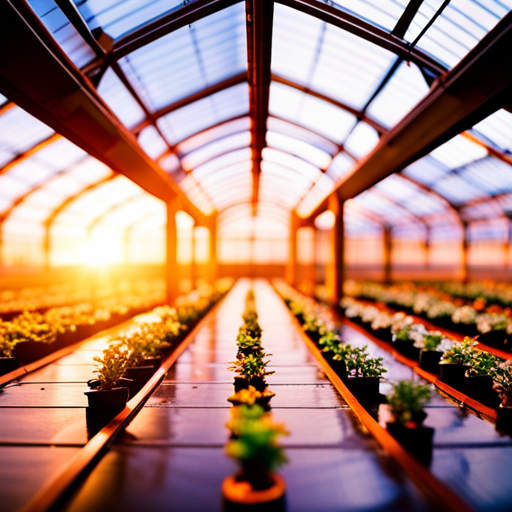Looking to extend your growing season? Discover sustainable techniques that can help you maximize your harvests.
From choosing cold-tolerant crops to utilizing hoop houses and greenhouses, there are plenty of options to explore.
Implementing row covers for frost protection and using season extenders are also effective strategies.
Don’t miss out on the opportunity to extend your growing season and enjoy a bountiful harvest all year round.
Choosing the Right Cold-Tolerant Crops
You should consider planting winter vegetables such as kale and Brussels sprouts to maximize your yield during the colder months. These cold-tolerant crops are perfect for extending your growing season and ensuring that you have fresh produce throughout the winter.
Kale is a nutrient-dense leafy green that thrives in colder temperatures. It can withstand frost and even snow, making it an ideal choice for winter gardening. Not only is kale easy to grow, but it’s also packed with vitamins A, C, and K, as well as antioxidants.
Brussels sprouts, on the other hand, are compact and versatile vegetables that can tolerate frost and cold temperatures. They require a longer growing season, so it’s important to plant them early in the fall. Brussels sprouts aren’t only delicious, but they also provide essential nutrients like vitamins C and K, fiber, and antioxidants.
Utilizing Hoop Houses and Greenhouses
To maximize your growing potential, consider utilizing hoop houses or greenhouses, which can provide a controlled environment for your plants. These structures are designed to extend the growing season by protecting your plants from harsh weather conditions such as frost, strong winds, and heavy rainfall.
Hoop houses are cost-effective and relatively easy to set up. They consist of a series of metal hoops covered with a transparent plastic sheeting, creating a mini greenhouse effect. Greenhouses, on the other hand, are more permanent structures made of glass or plastic panels. They offer better insulation and temperature control, allowing you to grow a wider range of plants throughout the year.
Both hoop houses and greenhouses provide protection from pests and diseases, giving your plants a better chance to thrive. They also allow you to control factors like temperature, humidity, and light, creating an ideal environment for your plants to grow and flourish.
Implementing Row Covers for Frost Protection
If you want to protect your plants from frost, consider implementing row covers, which can provide an extra layer of insulation. Row covers are lightweight, breathable fabrics that can be placed directly over your plants, creating a protective barrier against cold temperatures. These covers work by trapping heat from the soil and preventing it from escaping, creating a microclimate that keeps your plants warm and frost-free.
Row covers come in different thicknesses and materials, allowing you to choose the right one for your specific needs. They can be easily draped over your plants and secured with stakes or clips, providing a snug fit that prevents cold air from seeping in. Additionally, row covers are versatile and can be used throughout the growing season to protect your plants from pests, excessive heat, and harsh weather conditions.
Extending the Growing Season With Season Extenders
Using season extenders, such as hoop houses or cold frames, can significantly prolong the growing season for your plants. These structures create a microclimate that protects your plants from cold temperatures and frost, allowing you to start planting earlier in the spring and continue harvesting well into the fall.
Hoop houses are simple structures made of metal or PVC hoops covered with greenhouse plastic or row cover fabric. They can be easily constructed and provide excellent insulation for your crops.
Cold frames, on the other hand, are low-lying structures with transparent lids that capture sunlight and trap heat. They’re typically built with wood or cinder blocks and can be placed directly on the ground or on raised beds.
Both hoop houses and cold frames offer the added benefit of protecting your plants from pests and extreme weather conditions.
Maximizing Harvests With Succession Planting Techniques
You can maximize your harvests by implementing succession planting techniques and consistently replanting crops throughout the growing season. By doing so, you ensure a continuous supply of fresh produce and increase your overall yield.
Succession planting involves staggering the planting of crops at different intervals, allowing for a constant rotation of mature plants and new seedlings. This technique is especially beneficial for fast-growing crops like lettuce, radishes, and spinach.
To begin, choose crops that have a relatively short growing season and can tolerate cooler temperatures. Start by planting a small portion of your chosen crop, and then plant another batch a few weeks later. This way, you can enjoy a continuous harvest without the risk of overwhelming yourself with a surplus of produce all at once.
Consistently replanting crops is also crucial for maximizing your harvests. As soon as one crop is harvested, immediately replant the same area with a new batch of seeds or seedlings. This ensures that there’s no wasted space in your garden and that you’re always making the most of your growing season.
Additionally, it’s important to keep track of planting dates and make note of when each crop should be harvested. This way, you can plan your succession planting accordingly and avoid any gaps in your harvests.
Conclusion
So there you have it – sustainable techniques for extending the growing season.
By choosing cold-tolerant crops, utilizing hoop houses and greenhouses, implementing row covers, and using season extenders, you can maximize your harvest and enjoy fresh produce for a longer period of time.
With succession planting techniques, you can even continue planting and harvesting throughout the year.
So get out there, put these techniques into practice, and enjoy the rewards of a longer growing season.
Happy gardening!
